
vince_j_quaternions_for_computer_graphics
.pdf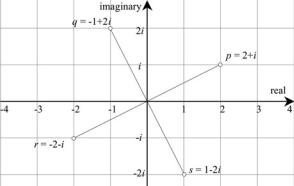
36 |
4 The Complex Plane |
Fig. 4.2 The complex plane with four complex numbers
The point p is rotated 90° to q by multiplying it by i:
i(2 + i) = 2i + i2
= −1 + 2i.
The point q is rotated another 90° to r by multiplying it by i: i(−1 + 2i) = −i + 2i2
= −2 − i.
The point r is rotated another 90° to s by multiplying it by i:
i(−2 − i) = −2i − i2
= 1 − 2i.
Finally, the point s is rotated 90° back to p by multiplying it by i:
i(1 − 2i) = i − 2i2
= 2 + i.
We also discovered in Chap. 3 that the sequence associated with increasing negative powers: (1, −i, −1, i, . . .) is a rotation in a clockwise direction, and implies that dividing a complex number by i rotates it 90° clockwise. However, we showed that i−1 = −i, and it is much easier to multiply a complex number by −i than divide it by i. So let’s repeat the above exercise to prove this point.
The point p is rotated −90° to s by multiplying it by −i:
−i(2 + i) = −2i − i2
= 1 − 2i.
The point s is rotated another −90° to r by multiplying it by −i:
−i(1 − 2i) = −i + 2i2
= −2 − i.
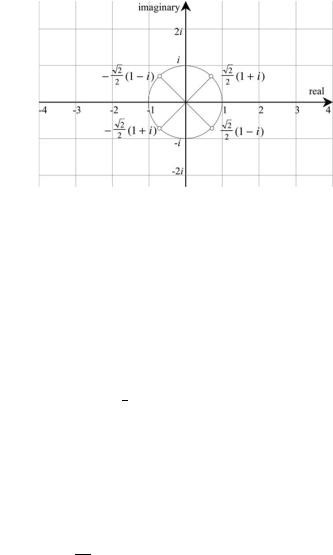
4.4 Polar Representation |
37 |
Fig. 4.3 The roots of ñi |
|
The point r is rotated another 90° to q by multiplying it by −i:
−i(−2 − i) = 2i + i2
= −1 + 2i.
Finally, the point q is rotated 90° back to p by multiplying it by −i:
−i(−1 + 2i) = i − 2i2
= 2 + i.
Thus a complex number is rotated ±90° by multiplying it by ±i. |
||||||||
In Chap. 3 we saw that the roots of √ |
±i |
are |
|
|||||
√ |
|
|
√2 |
|
|
|||
+i = ± |
(1 |
+ i) |
||||||
|
2 |
|||||||
√ |
|
|
√2 |
|
|
|||
−i = ± |
(1 |
− i) |
||||||
|
2 |
|||||||
and are shown in Fig. 4.3. Note that the individual roots are 180° apart, which sug-
gests that angles have something to do with their action. For example, the positive |
||||||||
root of √ |
|
is √ |
|
/2(1 + i) and is 45° from the real axis. Multiplying this root by |
||||
+i |
2 |
|||||||
itself rotates it 45° to the i axis. Similarly, the negative root is − |
√ |
|
|
|||||
2/2(1 + i) and is |
||||||||
|
||||||||
225° from the real axis. Multiplying this root by itself rotates it 225° to the i axis. The same is true for the roots of √−i.
These observations seem to suggest that we can construct a complex number capable of rotating another complex number through any angle. Which is true and is covered next.
4.4 Polar Representation
Placing a complex number on the complex plane leads us to polar representation where we form a line from the origin to the complex number as shown in Fig. 4.4.
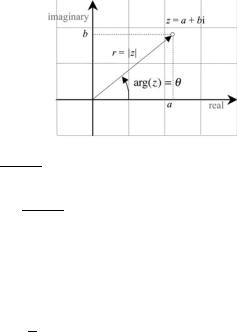
38 |
4 The Complex Plane |
Fig. 4.4 Polar representation of a complex number
√
The length of the line is r and equals a2 + b2, which is why the norm of a complex number is defined using the Pythagorean formula:
r = |z| = a2 + b2.
The angle θ between the line and the real axis is called the argument of z and written
arg(z) = θ
where
tan θ = b . a
We compute arg(z) using
1st quadrant a > 0, b > 0
2nd & 3rd quadrant a < 0 4th quadrant a > 0, b < 0
θ= arctan(b/a)
θ= arctan(b/a) + π
θ= arctan(b/a) + 2π.
We can see from Fig. 4.4 that the horizontal component of z is r cos θ and the vertical component is r sin θ , which permits us to write
z = a + bi
=r cos θ + r i sin θ
=r (cos θ + i sin θ ).
As mentioned above, one of Euler’s discoveries is the identity relating the power series for eθ , sin θ and cos θ :
eiθ = cos θ + i sin θ
which permits us to write
z = r eiθ .
Armed with this discovery, we are now in a position to revisit the product and quotient of two complex numbers using polar representation. For example, given the
4.4 Polar Representation |
39 |
following complex numbers
z = r eiθ w = seiφ
their product is
zw = r seiθ eiφ
=r sei(θ +φ)
=r s cos(θ + φ) + i sin(θ + φ) .
So the product of two complex numbers creates a third one with norm
|zw| = r s
and argument
arg(zw) = θ + φ
where the angles are added. Next, the quotient:
z |
= |
r eiθ |
|
||
w |
seiφ |
|
|
||
|
|
r |
|
||
|
= |
|
ei(θ −φ) |
|
|
|
s |
|
|||
|
= |
r |
− φ) + i sin(θ − φ) |
||
|
|
cos(θ |
|||
|
s |
||||
where the norm is |
|
|
|
|
|
z |
r |
||
w |
|
= s |
||
|
|
|
|
|
|
|
|
|
|
and the argument is
arg(z/w) = θ − φ
where the angles are subtracted.
Let’s employ these formulae with an example. Figure 4.5 shows two complex numbers
|
|
|
|
|
|
z = 2 + 2i |
|
|
|
|
|
which in polar form are |
|
|
|
|
|
w = −1 + i |
|
|
|
|
|
|
√ |
|
|
|
√ |
|
|
|
|||
|
|
|
|
|
|
|
iπ/4 |
||||
z = |
2 |
2(cos 45° + i sin 45°) |
= 2 |
2e |
|||||||
w = |
√ |
|
(cos 135° + i sin 135°) = |
√ |
|
ei3π/4. |
|||||
2 |
2 |
||||||||||
Using normal complex algebra, the product zw is
zw = (2 + 2i)(−1 + i) = −4
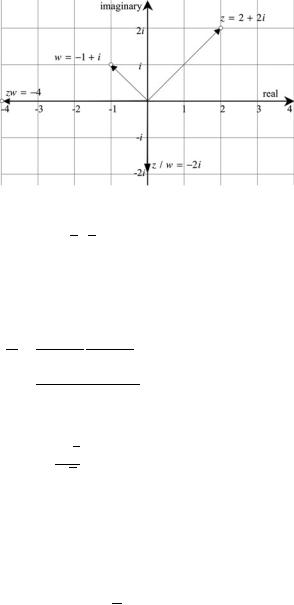
40 |
4 The Complex Plane |
Fig. 4.5 The product of two complex numbers
and using polar form:
√ √
|zw| = 2 2 2 = 4 arg(zw) = 45° + 135° = 180°
which encode −4.
Now let’s compute the quotient z/w using normal complex algebra and then polar form.
z = (2 + 2i) (−1 − i)
w (−1 + i) (−1 − i)
= −2 − 2i − 2i − 2i2
1 + 1
= −2i.
Next, using polar form:
√
2 2
|z/w| = √ = 2 2
arg(z/w) = 45° − 135° = −90°
which encode the complex number −2i. These results are shown in Fig. 4.5. |
||||||||||||||||||
We can also use Euler’s formula to compute √ |
i |
as follows |
||||||||||||||||
eiθ = cos θ + i sin θ |
||||||||||||||||||
substituting θ = π/2 we have |
|
|
|
|
|
|
|
π |
|
|
|
π |
||||||
eiπ/2 |
= cos |
|
|
|
||||||||||||||
|
+ i sin |
2 = i |
||||||||||||||||
2 |
||||||||||||||||||
taking the square root of both sides, we have |
|
|
|
√ |
|
|
||||||||||||
|
|
|
|
|
|
|
|
|
iπ/4 |
|
|
|
|
|
||||
|
|
|
|
|
|
|
|
|
|
|
|
|
||||||
|
π |
|
|
|
|
e |
π |
= ±√ |
i |
|
||||||||
cos |
|
|
|
+ i sin |
|
|
= ± |
|
|
i |
||||||||
|
4 |
4 |
|
|
|
|||||||||||||
|
|
√ |
|
|
|
|
|
|
|
|
|
|
√ |
|
|
|||
|
|
2 |
(1 + i) = ± |
|||||||||||||||
± |
|
|
|
|
|
|
i. |
|||||||||||
|
|
|
|
|
|
|||||||||||||
2

4.5 Rotors |
|
|
|
|
|
|
|
|
|
|
|
|
|
|
|
41 |
||
To find √ |
|
we substitute θ = −π/2: |
|
|
|
|
|
|
|
|||||||||
−i |
|
|
|
|
|
|
= −i |
|||||||||||
|
|
e−iπ/2 = cos − |
2 |
+ i sin − |
2 |
|||||||||||||
|
|
|
|
|
|
|
π |
|
|
|
|
|
|
|
|
π |
|
|
|
|
= cos |
2 |
− i sin |
2 |
|
= −i |
|||||||||||
|
|
|
|
|
π |
|
|
|
|
|
|
|
|
π |
|
|
|
|
taking the square root of both sides, we have |
|
|
|
|
|
|
||||||||||||
|
|
cos |
4 |
|
|
|
|
|
|
|
e−iπ/4 = ±√−i |
|||||||
|
|
− i sin |
4 |
|
= ±√−i |
|||||||||||||
|
|
|
π |
|
|
|
|
|
|
|
|
π |
|
|
|
|
|
|
|
|
|
|
|
√ |
|
|
|
|
|
|
|
√ |
|
||||
|
|
|
|
|
2 |
|
|
|
|
−i. |
||||||||
|
|
|
|
± |
|
(1 − i) |
= ± |
|
||||||||||
|
|
|
|
2 |
|
|||||||||||||
Higher roots can be found using a similar technique.
4.5 Rotors
The |
polar form brings home the fact that multiplying z |
= |
r eiθ |
with norm r , by |
||
|
iφ |
|
|
|
||
w = se |
|
with norm s, creates a third complex number with norm r s. Therefore, to |
||||
avoid scaling z, w must have a norm of unity. Under such conditions, w acts as a
rotor. For example, multiplying 4 + 5i |
by 1 + 0i leaves it unscaled and unrotated. |
||||||||||||||
|
|
|
|
|
|
|
|
|
|
|
|
|
any scaling. |
||
However, multiplying 4 + 5i by 0 + i rotates it by 90° withoutiπ/4 |
|
||||||||||||||
Therefore, to rotate 2 + 2i by 45°, we must multiply it by e |
|
: |
|||||||||||||
|
|
|
|
|
|
|
|
|
|
|
√ |
|
|
|
|
|
|
|
eiπ/4 = cos 45° + i sin 45° = |
2 |
(1 |
+ i) |
|||||||||
|
|
|
2 |
||||||||||||
√ |
|
|
|
√ |
|
|
|
|
|
|
|
|
|
|
|
2 |
(1 + i)(2 + 2i) = |
2 |
4i |
|
|
|
|
|
|||||||
|
2 |
|
2 |
|
|
|
|
|
|
|
|||||
|
|
|
= |
|
√ |
|
|
|
|
|
|
|
|||
|
|
|
2 |
|
2i. |
|
|
|
|
|
|||||
rotates any complex number through an angle θ .
To rotate a complex number x + yi through an angle θ we can multiply it by the
rotor cos θ + i sin θ : |
|
|
|
|
|
|
x + y i = (cos θ + i sin θ )(x + yi) |
|
|||||
which in matrix form is: |
= x cos θ − y sin θ + i(x sin θ + y cos θ ) |
|||||
x |
= sin θ |
|
y |
x |
||
y |
|
cos θ |
||||
x |
|
−y |
cos θ |
− sin θ |
x |
−y . |
Before moving on let’s consider the effect the complex conjugate of a rotor has on rotational direction, and we can do this by multiplying x + yi by the rotor

42 |
|
|
|
|
|
|
|
|
|
4 The Complex Plane |
cos θ − i sin θ : |
|
|
|
|
|
|
|
|
|
|
x + y i = (cos θ − i sin θ )(x + yi) |
|
|
||||||||
and in matrix form is |
|
= x cos θ + y sin θ − i(x sin θ + y cos θ ) |
||||||||
|
x |
|
= |
|
sin θ |
cos θ |
y |
|
|
|
y |
|
|
x |
|||||||
x |
|
−y |
|
cos θ |
sin θ |
x |
−y |
|
||
|
|
|
|
|
− |
|
|
|
|
|
which is a rotation of −θ about the origin. |
|
† |
|
|
||||||
Therefore, we define a rotor Rθ and its conjugate Rθ |
as |
|
||||||||
Rθ = cos θ + i sin θ R†θ = cos θ − i sin θ
where Rθ rotates +θ , and R†θ rotates −θ . Note, the use of the dagger † symbol.
4.6 Summary
In this chapter we have discovered a graphical interpretation for complex numbers using the complex plane. Euler’s formula eiθ = cos θ + i sin θ permits us to express a complex number as an imaginary power of e, which in turn allows us to compute products and quotients easily. Collectively, these ideas have lead us towards the idea of a rotor, which will be developed using quaternions.
4.6.1 Summary of Operations
Complex number
z = a + bi
|z| = a2 + b2
Polar form
z= r eiθ
z= r (cos θ + i sin θ ) r = |z|
tan θ = b/a
|
θ = arg(z) |
|
1st quadrant |
a > 0, b > 0 |
θ = arctan(b/a) |
2nd and 3rd quadrant a < 0 |
θ = arctan(b/a) + π |
|
4th quadrant |
a > 0, b < 0 |
θ = arctan(b/a) + 2π |

4.7 Worked Examples |
43 |
Product
z = r eiθ w = seiφ
zw = r sei(θ +φ)
= r s cos(θ + φ) + i sin(θ + φ)
Quotient
z = r ei(θ −φ)
ws
=r cos(θ − φ) + i sin(θ − φ) s
Rotors
Rθ = cos θ + i sin θ
R†θ = cos θ − i sin θ
4.7 Worked Examples
Here are some further worked examples that employ the ideas described above. In some cases, a test is included to confirm the result.
Example 1 Starting with 1 + 2i, multiply the resulting complex number by i four times, and plot the result on the complex plane.
The point p is rotated 90° to q by multiplying it by i:
i(1 + 2i) = i + 2i2
= −2 + i.
The point q is rotated another 90° to r by multiplying it by i: i(−2 + i) = −2i + i2
= −1 − 2i.
The point r is rotated another 90° to s by multiplying it by i: i(−1 − 2i) = −i − 2i2
= 2 − i.
Finally, the point s is rotated 90° back to p by multiplying it by i:
i(2 − i) = 2i − i2
= 2 + i.
Figure 4.6 shows the four complex numbers separated by 90°.
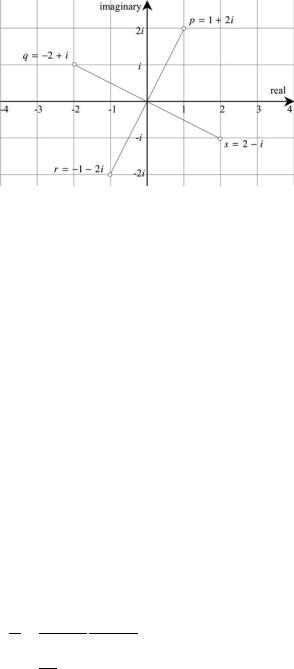
44 |
4 The Complex Plane |
Fig. 4.6 The complex plane with four complex numbers
Example 2 Compute the product zw and quotient z/w using polar form.
|
|
|
|
|
|
|
|
z = 3 + 3i |
|
|
|
|
|
Product: |
|
|
|
|
|
|
w = −1 − i. |
|
|
|
|
|
|
|
√ |
|
|
|
|
|
√ |
|
|
|
|||
|
|
|
|
|
|
|
|
|
iπ/4 |
||||
z = |
3 |
2(cos 45° + i sin 45°) |
= 3 |
2e |
|||||||||
w = |
√ |
|
(cos 225° + i sin 225°) = |
√ |
|
ei5π/4 |
|||||||
2 |
2 |
||||||||||||
|zw| = |
|
√ |
|
√ |
|
= 6 |
|
|
|
|
|
||
3 |
|
2 |
|
2 |
|
|
|
|
|
||||
arg(zw) = |
45° + 225° = 270° |
|
|
|
|
|
|||||||
which encode the complex number −6i.
Test: Using normal complex algebra, the product zw is
zw = (3 + 3i)(−1 − i) = −6i.
Quotient: |
√ |
|
|
|
|
||
|z| = |
|
|
|
|
|||
3 |
|
|
2 |
|
|
|
|
|w| = |
√ |
|
|
|
|
|
|
2 |
|
|
√ |
|
|
||
|z/w| = |
√ |
|
|
= 3 |
|||
3 |
|
|
2/ 2 |
||||
arg(z/w) = 45° − 225° = 180°
which encode the complex number −3.
Test: Using normal complex algebra, the quotient z/w is
z = (3 + 3i) (−1 + i)
w(−1 − i) (−1 + i)
=−6 2
=−3
and agrees with the polar form.

4.7 Worked Examples |
45 |
Example 3 Design a rotor to rotate a complex number through 30° without scaling. Starting with
eiθ = cos θ + i sin θ
let θ = 30° = π/6
eiπ/6 = cos 30° + i sin 30°
√
=3 + i 1
|
|
|
|
|
|
|
|
|
|
|
|
2 |
√ |
|
2 |
|
|
|
|
|
|
|
|
|
|
|
|
|
|
|
|
|||
|
|
|
|
|
|
|
|
|
|
= |
1 |
|
|
+ i . |
|
|
|
|
|
|
|
|
|
|
|
|||||||||
|
|
|
|
|
|
|
|
|
|
|
|
|
|
|
|
|
|
|
|
|
|
|
||||||||||||
|
|
|
|
|
|
|
|
|
|
|
|
|
3 |
|
|
|
|
|
|
|
|
|
|
|
||||||||||
|
|
|
|
|
|
|
|
|
|
|
2 |
|
|
|
|
|
|
|
|
|
|
|
||||||||||||
Test: Let’s rotate 1 + 0i three times by this rotor to i. |
|
|
|
|
|
|
|
|
|
|
|
|||||||||||||||||||||||
1 √ |
|
1 √ |
|
1 √ |
|
|
|
|
|
|
|
1 |
√ |
|
|
|
|
|
|
√ |
|
|
|
|
√ |
|
|
|||||||
|
|
|
|
|
|
|
|
|
|
|
|
|
|
|
||||||||||||||||||||
|
|
( |
3 + i) |
|
( |
3 + i) |
|
( 3 |
|
+ i)1 |
= |
|
( 3 + i)( 3 |
+ i)( 3 |
+ i) |
|||||||||||||||||||
2 |
2 |
2 |
|
8 |
||||||||||||||||||||||||||||||
|
|
|
|
|
|
|
|
|
|
|
|
|
|
|
|
|
|
1 |
|
|
|
|
|
√ |
|
|
|
√ |
|
|
|
|||
|
|
|
|
|
|
|
|
|
|
|
|
|
|
|
|
|
|
|
|
|
|
|
|
|
|
3 + i) |
|
|||||||
|
|
|
|
|
|
|
|
|
|
|
|
|
|
|
|
|
= |
|
(2 + 2 |
3i)( |
|
|
||||||||||||
|
|
|
|
|
|
|
|
|
|
|
|
|
|
|
|
|
8 |
|
||||||||||||||||
|
|
|
|
|
|
|
|
|
|
|
|
|
|
|
|
|
= |
1 |
√ |
|
|
− |
|
√ |
|
|
+ 2i + 6i) |
|||||||
|
|
|
|
|
|
|
|
|
|
|
|
|
|
|
|
|
|
(2 3 |
|
2 3 |
|
|||||||||||||
|
|
|
|
|
|
|
|
|
|
|
|
|
|
|
|
|
8 |
|||||||||||||||||
= i.
Example 4 Design a rotor to rotate a complex number through −60° without scaling.
Starting with
eiθ = cos θ + i sin θ
let θ = −60° = −π/3
e−iπ/3 = cos(−60°) + i sin(−60°)
√
= 1 − 3 i
22
1√
=(1 − 3i).
2
